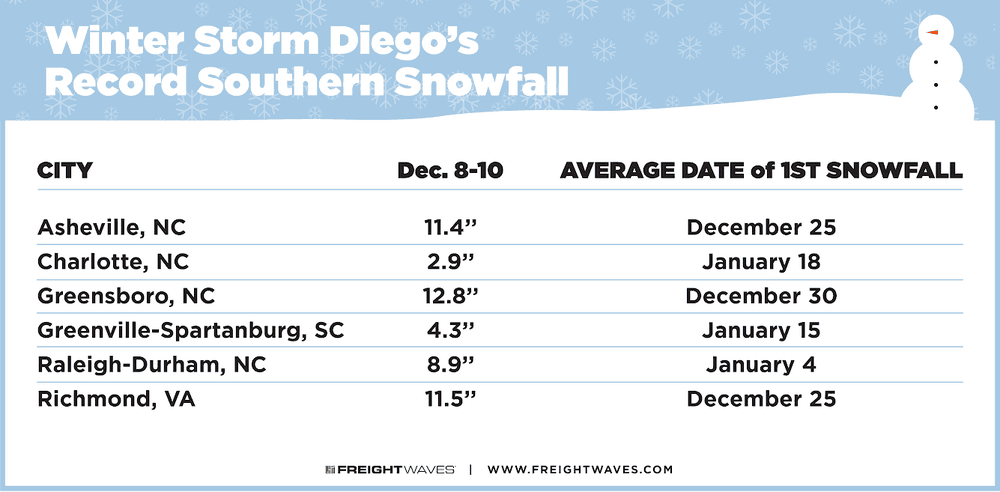Now that most of the snow has melted, Winter Storm Diego is finally just a memory to people in the South. Record snowfall came early in the season, technically before winter began on the calendar. Here’s a look back at what happened and how the storm affected lives and freight movement across the region.
Storm Development
Diego started dropping lots of rain out west on Wednesday, December 5, flooding parts of southern California for two days. Then the vigorous low pressure system intensified and headed eastward, drenching the Gulf Coast on Friday, December 7, while dumping several inches of snow in the Texas Panhandle that night. Over the weekend of December 8 and 9, Diego tracked to the northeast where plenty of cold air – cold enough to support snow – had settled into eastern Tennessee, the Carolinas, and Virginia. Abundant moisture led to large amounts of snow for this part of the country before the storm left the area late on December 10.
Record Snowfall
Mount Mitchell in western North Carolina topped the heap with 34 inches of snow. Several cities had more snow than they had seen in decades for this time of year, getting socked with an entire winter’s worth of snow in one day.
The graphic below shows snow totals for Winter Storm Diego. While the storm didn’t set records for total December snowfall or single-storm snowfall, the six cities listed did set records for the most snow ever for the date of December 9. Although these areas of the South get wintry precipitation from time to time, it was unusually early in the season for a storm of this magnitude. On average, two of the cities on the list don’t see snow amounts greater than a trace until Christmas, while people in other cities usually have to wait until January.

Impact on Transportation and Lives
Diego made for pretty scenes in the Southeast, but the storm also had an ugly side. North Carolina Highway Patrol officials told FreightWaves they reported 2,328 accidents on state highways during the storm, and responded to 5,816 calls for action which included helping with road blocks and stranded drivers.
A truck driver died of an apparent heart attack after trying to dig his big rig out of the snow in Yadkin County, North Carolina. He got stuck on I-77 about halfway between Boone and Greensboro, several miles north of the intersection at US-421. Keith Vestal, Yadkin County Emergency Services Director, told FreightWaves the man experienced chest pain shortly after he started shoveling and became unconscious at the scene. CPR was performed on the driver, and he was taken to the nearest hospital which happened to be in neighboring Surry County. He was pronounced dead at the hospital. The man’s name hasn’t been released to the public yet, but Vestal says he considers the death storm-related, and that the driver was from out-of-state. Two other people in North Carolina and one in Tennessee died because of the storm.
Airlines cancelled around 1,400 flights into and out of Charlotte and other southern airports during the weekend of the storm. On top of everything else, more than 300,000 customers at one point lost electricity across the Carolinas, east Tennessee, and Virginia.
Impact on Freight Movement
Winter Storm Diego didn’t produce national or large regional changes to freight movement like the four March Nor’easters did across the Mid-Atlantic and New England states. However, the storm had localized effects on the movement of goods. Charlotte had the most noticeable changes of all major southern freight markets.
A good indicator is the amount of outbound loads that are rejected by carriers. The chart above shows outbound rejection rates falling in Charlotte in the days leading up to the storm on December 8 and 9, as carriers attempted to move out as many loads as possible before Diego’s arrival. Outbound rejections then rose by nearly 40 percent by the end of the week following the storm as freight started to flow again.
In Summary
For the South, Diego was a fairly bad winter storm in terms of its timing and intensity, but it’s a good thing it didn’t last longer or produce lots of ice. Unfortunately, souls perished, but many people were rescued from dangerous situations by first responders who were prepared and who did what they could to make sure the public was prepared. From the transportation industry side, Diego only caused a brief disruption for some drivers and fleet managers. Staying ahead of the storm will be critical again before the next round of snow enters the forecast.










